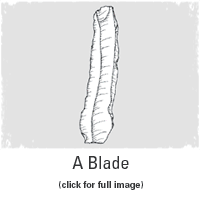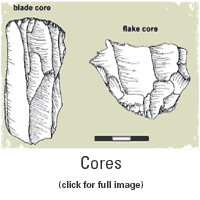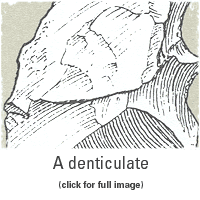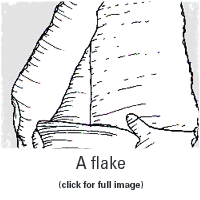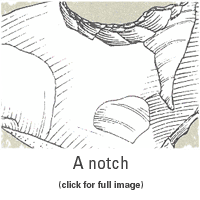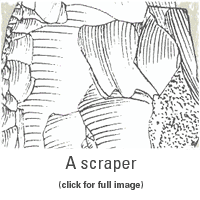Skip to a section of the glossary: A B C D F H M N S T
Asinipodian
Typologically, the Asinipodian resembles either a Denticulate Mousterian or a Typical Mousterian rich in denticulates, as there are more notches/denticulates than scrapers. One other type, however, is heavily represented in these layers, namely truncated-faceted pieces. This type was not recognized in Bordes' analysis (not being a part of his original type-list), and so did not figure into the original definition. Now truncated-faceted pieces are known to occur in varying frequencies in Middle Paleolithic assemblages from all over the Old World. Bordes did, however, recognize two other characteristic features of the Asinipodian, namely the high percentages of Kombewa flakes and cores and the production of very small Levallois flakes (many less than 2 cm in length). In fact, there is a whole continuum from small Levallois cores, truncated-faceted pieces, and Kombewa cores, all of which were used to produce extremely small flakes that were presumably used in an unretouched state. While all of these features do exist in other Mousterian facies, they appear together and in such high frequency only in the Asinipodian.
Blade
A piece of stone struck from a core during flintknapping. It is usually at least twice as long as it is wide, and has evidence of prior removals on its exterior (dorsal) surface. These prior removals have left parallel ridge lines.
Core
A piece of stone from which a flintknapper has removed flakes or blades. Cores are most often flint or chert, but can also be obsidian (volcanic glass), basalt, rhyolite, quartzite, and other types of stone that fracture conchoidally.
Cores, Kombewa
Kombewa cores are actually flakes that have been used as cores to remove a smaller flake from the interior surface, especially near the original bulb of percussion.
Cores, Radially Prepared
Radially prepared cores are usually circular cores with preparation flakes coming from all of the sides.
Denticulate
A flake or blade that has two or more concave removals.
Flake
A piece of stone struck from a nodule or core during flintknapping. It is usually relatively wide compared to its length.
Hunter-gatherers
Groups of people whose economy is based on hunting animals and gathering plants for food. They tend to be relatively mobile, that is, they don�t live in settled villages and don�t have agriculture. Hunter-gatherers typically move from place to place throughout the year, depending on the availability of food, water, and other critical resources. Until about 10,000 years ago, all people worldwide were hunter-gatherers. Today, there are only a few hunter-gatherer groups, mainly located in Australia and southern Africa.
Middle Paleolithic Period
The Middle Paleolithic has been traditionally defined as a flake tool industry, which was meant to differentiate it from earlier Acheulian industries (with bifaces, or handaxes) and later Upper Paleolithic industries (characterized by blades and blade tools). Typologically, that is in terms of the retouched lithics, Middle Paleolithic assemblages are often composed of two major classes of tools: scrapers and notches/denticulates. Scrapers are tools that exhibit a continuous and generally smooth retouching along one or more (usually lateral) edges. Notches are flakes that have a relatively deep concavity along an edge produced either by a single blow or a series of fine retouch removals. Denticulates are types which have two or more adjacent notches. Recent work has radically altered notions regarding the chronology of the Middle Paleolithic. Traditionally, the Mousterian was thought to date from only the early part of the last glacial, or about 80,000 BP, with some occurrences of earlier last Interglacial industries termed "Premousterian." The revised chronology, based on correlations of marine and terrestrial sequences, now suggests that the date of the onset of the last glacial period, or Würm (oxygen-isotope stage 5d) is 115,000 BP, extending the duration of the Würmian industries by as much as fifty percent. Moreover, assemblages absolutely characteristic of the Middle Paleolithic are now known to date to oxygen-isotope stage 8, or about 250,000 BP.
Mousterian
a. The Mousterian is a term applied to Middle Paleolithic industries of Western Europe. Generally these date from about 250,000 years ago until about 35,000 years ago. The are associated with Neandertals. The most prevalent types of stone tools are scrapers, notches and denticulates, and bifaces, although there is considerable variability among assemblages in terms of the relative proportions of each of these major tool categories.
Mousterian, Charentian
Two subtypes compose this grouping, the Ferrassie and the Quina Mousterian. Both have moderate to high frequencies of scrapers, as well as a moderate representation of notched flakes. The Ferrassie Mousterian has Levallois technique, while the Quina Mousterian does not. Certain scraper forms thus differ between the two subtypes, for example, transverse scrapers are more common in the Quina Mousterian.
Mousterian, Denticulate
This type of stone tool assemblage is characterized by high frequencies of notches and denticulates and low frequencies of scrapers. Levallois technique may or may not be present.
Mousterian of Acheulian Tradition
This type of Mousterian assemblage also has two subtypes, A and B. Subtype A has numerous handaxes, a moderate number of scrapers, and examples of Upper Paleolithic tools such as endscrapers, burins, and truncated blades. Subtype B, on the other hand, has few handaxes and few sidescrapers, but does have numerous backed knives and denticulates, as well as Upper Paleolithic tool types.
Mousterian, Typical
These assemblages contain moderate frequencies of scrapers, and low frequencies of notches and denticulates. Levallois technique is variably present.
Neandertal
Extinct group of hominids who lived in Western Eurasia (Europe and the Middle East) between about 130,000 and 30,000 years ago. Their relationship to anatomically modern humans (Homo sapiens sapiens) is the subject of much on-going debate. Some researchers believe that Neandertals were a separate species (Homo neanderthalensis), who went extinct without contributing to the gene pool of modern humans. Other researchers think that Neandertals are part of modern human ancestry, so that the differences between them and us are at the subspecies level (Homo sapiens neanderthalensis). There is also much debate about whether Neandertals exhibited behavioral strategies that we would identify as modern.
Negative Scars (of flakes)
When a flake is removed from a core, it leaves a small depression on the core surface. This depression is the negative scar.
Notch
A flake or blade that has one concave removal.
Scientific Method
The objective, unbiased process by which scientists test explanations for their observations. The first step is to make a specific observation about something, for example, a set of artifacts from an archaeological site. The next step is to develop explanations (hypotheses) for the observation. These hypotheses are then tested to assess their validity as explanations. For example, an observation might be that some stone tools have polish. Explanations for this observation might include: 1) the polish is the result of natural processes such as chemical depositions on some stone artifacts after they are buried; 2) the polish is the result of cutting certain types of plants; or 3) the polish comes from rubbing a coarse stone (in the manner of sandpaper) against a finer grain stone artifact that then acquires a polish. Testing these hypothesis would involve a combination of chemical testing of the polishes, experimental archaeology to replicate polish on stone artifacts, microscopic examination of the polishes, and so forth.
Scraper
A flake or blade that has been retouched along one or both of its lateral edges, or along one or both ends, to create a sharp edge.
Stone Artifacts
Pieces of stone that have been culturally manufactured during flintknapping. They include all types of stone tools, such as scrapers and denticulates, and all the removals from a core, such as flakes and blades, as well as the products of resharpening stone tools, such as tiny flakes, and manufacturing debris, such as shatter.
Theodolite
Optical equipment used in survey and archaeological excavations. It has a small mounted telescope that can be rotated both horizontally and vertically.
Total Station
A theodolite with an EDM (electronic distance meter) that can automatically measure and compute the three-dimensional, Cartesian coordinates of a measured point (X, Y, and Z points or Easting, Northing, and Elevation).








